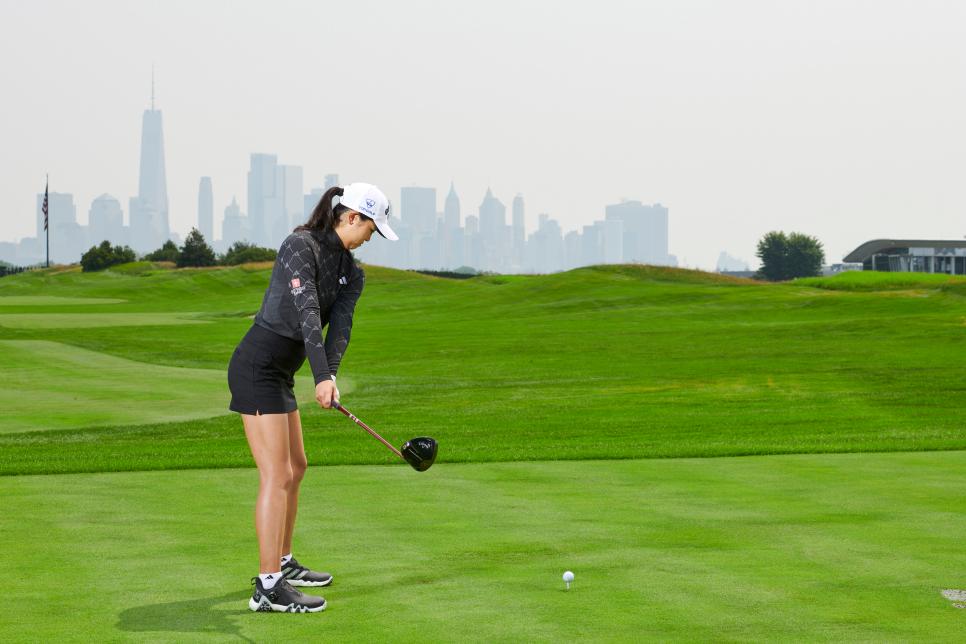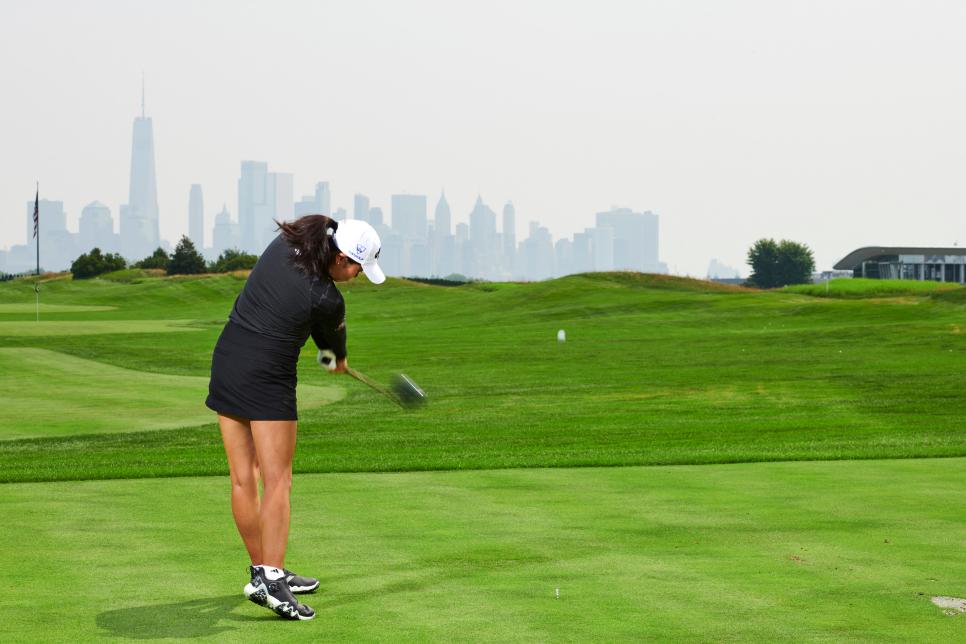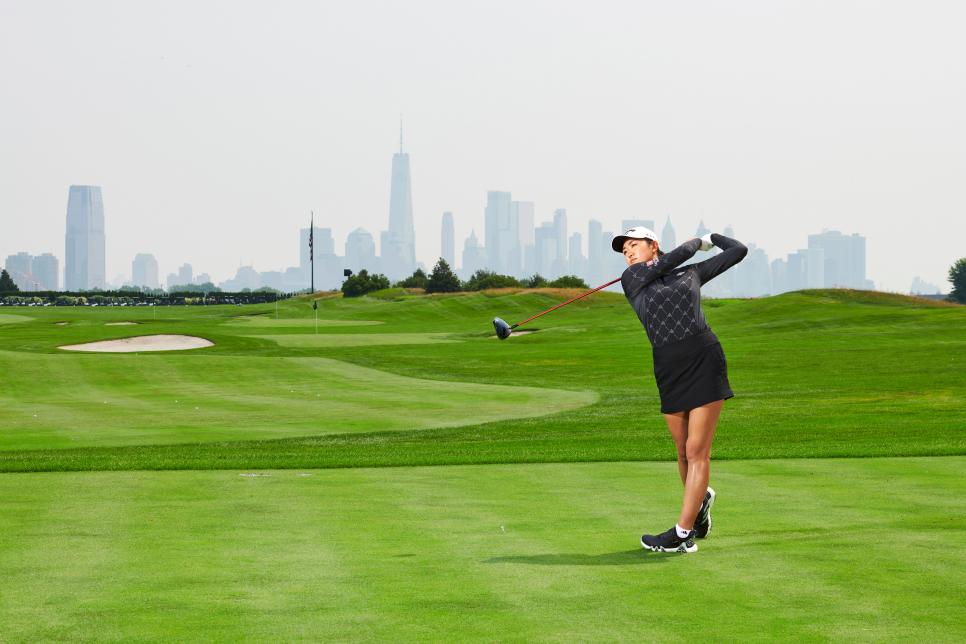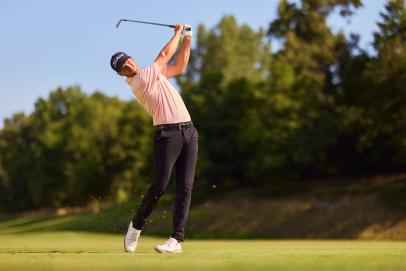SMOOTH IT OUT THERE
How to make your best ball-striking feel effortless like Rose Zhang

Ever since I was 9 or 10, I’ve had it ingrained in my mind to never hit the ball harder than I need to.
It’s why when you watch me play, my swing tempo looks so mellow. Even now that I’m on the LPGA Tour, where I’m competing with golfers who sometimes outdrive me by 50 yards, I’m still focused on making a smooth, simple swing that produces the best contact possible. Can I hit it farther than my 255-yard driving average? Absolutely. At times I’ve experimented with different techniques to get more distance. But I’ve found it’s not the way I play my best.
It’s probably not the way you’ll play your best, either.
I can say that because I’ve played with a lot of amateurs going back to my days in junior golf. I can’t tell you how many times someone in my group would watch me for a few holes and then comment on how smooth and easy I swung the club. As the round went on, they would naturally gravitate toward copying my tempo. The closer they came to it, the better they struck the ball. When you focus on solid contact instead of trying to go all-out, your chance of keeping the ball in play and controlling distance is going to go way up.
If you don’t have time to hit balls every day, then copying my swing is a more achievable goal than trying to be like those PGA Tour pros who smash it. Let me show you some of the things my coach, George Pinnell, and I focus on to hit the ball dead center every time. We’ve been together since before I was a teenager, and believe me, we’ve worn out the sweet spot on a lot of my clubs this way. —with Ron Kaspriske
PRE-SWING

Mackenzie Stroh
ELIMINATE MISTAKES BEFORE YOU START
If your swing is perfect, but you’re aiming 20 yards left or right of where you should be, or your hands aren’t holding the club in a way that gives you good awareness of the face, there’s no point in having a perfect swing. That’s why I always check my alignment and grip. Get those things right, and it’s just two less things to worry about. It also makes it easier to figure out what’s going right or wrong when you do hit some shots.
Aligning correctly when you step into your shot is huge, but the biggest thing for me is, I want to see my hands matching up with the orientation of the clubface at address (above). We call it a “neutral-grip position.” That means the palm of my right hand and back of my left hand are facing my target, just like the clubface. When everything is matching, it makes it easier to square things up at impact.

Mackenzie Stroh
GOING BACK
STAY FLUID AND WIDE
It’s OK if you take the club back faster than I do because I know my slow start is tough to copy. If you are faster, you still have to avoid jerking the club back and whipping it inside the target line. The move should feel smooth. To take the club back correctly, my lower body stays quiet, and the first few feet of the swing are controlled by a coordinated rotation of my upper body and arms. They work together. The mistake is to start back only with your arms.
Also, if you can’t generate power with a lot of swing speed, it’s important to maintain your swing’s width like I do. That’s something George and I have been working on. You want to see the clubhead outside my hands at this point in the backswing (above). That means my swing is staying nice and wide, and that extra distance the club travels helps compensate for slower swings. It also improves your chance of solid contact because you don’t have to do anything extra to get the club back to the ball. Think to yourself, Start wide and stay wide.

Mackenzie Stroh
AT THE TOP
GET THE SLACK OUT OF YOUR SWING
A lot of people worry about how far they take the club back before they start the downswing. I don’t think that’s the priority for players like us. It’s more important to take any extra movement out of the swing. My coach calls the extra motions “slack,” and we don’t want any as I swing back and down. My tendency is to sometimes take the club back with my hands too high. Or every now and then the shaft gets laid off (flattens) as I reach the top. These extra movements—the slack—have to be eliminated or greatly reduced if you want to put the middle of the clubface on the ball with consistency.
Your best chance at hitting the ball solidly is to feel like you’re nice and wound as you reach the top (above). The mistake is to sense you’re straining as you finish the backswing, or worse, you didn’t wind up at all—you took the club back with only your arms. Instead, you should feel comfortable and in control at the top. My footwork really helps set that up. I want to feel pressure on the inside of my right heel.

Mackenzie Stroh
THROUGH IMPACT
SHIFT, THEN UNWIND—SMOOTHLY
Two things George and I focus on are footwork and weight shift. I’m a big believer that the swing happens from the ground up. Before I come down into the ball, I want to get most of my weight into my front side. The goal is to rotate around my left leg like it’s a post. This move would definitely help you if you tend to swing off your back foot and hit a lot of fat and thin shots. It also helps keep your upper body from drifting ahead of the ball in the downswing—a mistake that also leads to mis-hits.
As you unwind around your front leg, try to accelerate smoothly with the club. When I start my downswing, I make sure there’s no rush. You can see that I’m swinging pretty fast here (above), but most of the speed happens down around the ball. If you start down fast from the top, your timing and tempo will be off and you won’t be accelerating as you hit the shot. As George likes to say, let your club “find the ball.” Remember, you’re trying to make solid contact more than anything else.

Mackenzie Stroh
THE FINISH
LEAVE SOME IN THE TANK AND STRIKE A POSE
I’m only hitting the ball with 75-percent effort. That might surprise you, but as long as it’s a full swing, my tempo and effort are the same whether it’s a wedge or a driver. As I mentioned, I have experimented with swinging harder. You should, too. Making some swings as fast as you can when you practice will help you feel the difference between a smooth swing that “finds the ball” and a fast swing that produces an off-center hit. You’ll start to really understand what pace produces the most solid shots for you.
More from Golf Digest
Another thing to think about is your finish. Recently I’ve been working on making mine less messy. Players like Tiger and Rory make that a huge emphasis. Why? When you finish in balance, fully unwound (above), it means you made a good swing regardless of where the ball goes. If you swing at 75 percent, you’ll find it’s much easier to do that—and I bet someone compliments you on how smooth you look!



